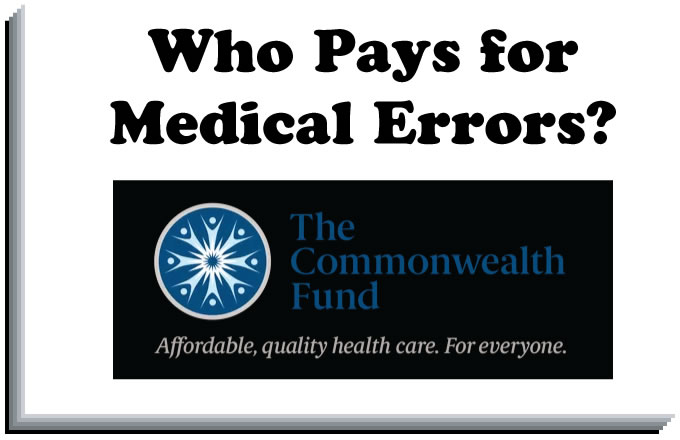In 2000, Dr. Barbara Starfield published a study revealing that doctors are the third leading cause of death in the U.S., killing an estimated 225,000 patients each year
According to a new study, medical errors kill an estimated 250,000 Americans each year, confirming that modern medicine is still the third leading cause of death in the U.S.
The CDC doesn’t collect or publish information relating to medical errors or deaths attributed to iatrogenic causes. The researchers urge the CDC to include coding for medical errors on death certificates
By Dr. Mercola
History tells us it can take decades before a medical truth becomes accepted as fact, and recent headlines are a perfect example of this.
Sixteen years ago, I read an article in the Journal of the American Medical Association (JAMA) that stunned me. I was shocked. JAMA published it. Although the article did not explicitly state it, the data was very clear.
So I published my summary of the study, which revealed that doctors are in fact the third leading cause of death in the U.S.1
You likely have seen this statistic or headline, but you may not be aware that I was the one who created that headline, which has been widely circulated on the internet and virtually never attributed to me as the person who saw through the data to make that conclusion.
Dr. Barbara Starfield was the author of that JAMA study, published in 2000, and her research documented how a staggering 225,000 Americans die from iatrogenic causes, meaning their death is caused by a physician's or hospital's activity, manner, or therapy. Her statistics showed that each year:
- 12,000 die from unnecessary surgery
- 7,000 die from medication errors in hospitals
- 20,000 die from other errors in hospitals
- 80,000 die from hospital-acquired infections
- 106,000 die from the negative side effects of drugs taken as prescribed
Back then, few people believed it, but in recent days headlines echoing my original 2000 article have made the rounds in many of the major media outlets.
One of the reasons why many are still surprised by these statistics is due to fundamental flaws in the tracking of medical errors, which has shielded the reality of the situation and kept it out of the public eye.
Medical Errors Are STILL the Third Leading Cause of Death
Starfield's findings 16 years ago still stand today. In fact, recent research suggests matters have only gotten worse, and the reason for this is because no affirmative action was ever taken to address and correct the situation.
According to a new study8 published in the British Medical Journal (BMJ), medical errors now kill an estimated 250,000 Americans each year, an increase of about 25,000 people annually from Starfield's estimates.
That means medical errors are STILL the third leading cause of death, right after heart disease and cancer. These numbers may actually be vastly underestimated, as deaths occurring at home or in nursing homes are not included.
As shown by Starfield's research, side effects from drugs, taken as prescribed, account for the vast majority of iatrogenic deaths. Research9 published in 2013 estimated that preventable hospital errors kill 210,000 Americans each year — a figure that is very close to the latest statistics.
However, when they included deaths related to diagnostic errors, errors of omission, and failure to follow guidelines, the number skyrocketed to 440,000 preventable hospital deaths each year. This too hints at the true enormity of the problem.
Cause of Death Reporting Needs an Overhaul
According to Centers for Disease Control and Prevention (CDC) statistics, the third leading cause of death is respiratory disease, which claims 150,000 lives each year, not iatrogenic causes. In fact, the CDC doesn't publish any information relating to medical errors at all. As reported by Newsweek:
"The researchers for the study from Johns Hopkins say their findings suggest the CDC's method for collecting data on causes of death is flawed, leading to inaccurate estimates on just how dangerous a visit to your local hospital has become.
Death certificates currently don't have a separate coding classification for medical errors, which means estimates are not accurate.
The medical coding system used by the CDC was originally developed for physicians and hospitals to determine what to bill health insurance companies for individualized patient care. The authors recommend an overhaul of how cause of death data is collected."
The researchers suggest adding an extra field to the death certificate, asking whether a preventable complication or medical error contributed to the death. At present, no such checkbox exists. Instead, when a patient dies from a medical error, the original complaint is listed as the cause of death.
They also recommend a number of strategies to reduce the number of deaths from iatrogenic causes, including increased transparency and communication. As long as health care providers and hospital administrators remain in the dark about the severity of the problem, few course corrections are likely to be made.
Iatrogenic Deaths Are a Global Problem
Bob Anderson, Ph.D. chief of the Mortality Statistics branch for the CDC, claims there are codes that capture iatrogenic causes of death. However, the published mortality statistics do not take them into account. They only look at the condition that led the individual to seek medical treatment in the first place.
As a result, even if a doctor lists medical errors in the death certificate, they are not included in the CDC's mortality statistics.
Anderson defends the agency's approach, saying it's "consistent with international guidelines." In essence, most countries tally their deaths in a similar fashion, in order to be able to compare mortality statistics internationally.
All that really means is that this is a global problem, and all nations really need to take a closer look at how deaths are recorded and counted. According to Anderson, the CDC is unlikely to change the recording of deaths unless there's a really compelling reason to do so. But what could be more compelling than the fact that modern medicine is a leading cause of preventable deaths!?
Starfield's Ironic Tragedy — A Victim to What She Chronicled
Ironically, Starfield became a statistic to her own research. She died suddenly in June 2011, a death her husband attributed to the adverse effects of the blood thinner Plavix taken in combination with aspirin. However, her death certificate makes no mention of this possibility. In the August 2012 issue of Archives for Internal Medicine11 her husband, Dr. Neil A. Holtzman, writes, in part:
"Writing in sorrow and anger, I express up front my potential conflict of interest in interpreting the facts surrounding the death of my wife, Dr. Barbara Starfield, ... Because she died while swimming alone, an autopsy was required. The immediate cause of death was 'pool drowning,' but the underlying condition, 'cerebral hemorrhage,' stunned me ...
Barbara started taking low-dose aspirin after coronary insufficiency had been diagnosed three years before her death, and clopidogrel bisulfate (Plavix) after her right main coronary artery had been stented six months after the diagnosis. She reported to the cardiologist that she bruised more easily while taking clopidogrel and bled longer following minor cuts. She had no personal or family history of bleeding tendency or hypertension.
The autopsy findings and the official lack of feedback prompted me to call attention to deficiencies in medical care and clinical research in the United States reified by Barbara's death and how the deficiencies can be rectified. Ironically, Barbara had written about all of them."
US Health Care System Is an Unmitigated Failure at Treating Chronic Illness
The U.S. has the most expensive health care in the world, spending more on health care than the next 10 biggest spenders combined (Japan, Germany, France, China, the U.K., Italy, Canada, Brazil, Spain and Australia). If the U.S. health care system were a country, it would be the 6th largest economy on the entire planet.
Despite that, the U.S. ranks last in health and mortality when compared with 17 other developed nations. We may have one of the best systems for treating acute surgical emergencies, but the American medical system is clearly an unmitigated failure when it comes to treating chronic illness. The fact that properly prescribed and administered drugs kill at least 106,000 should really be food for some serious thought. For starters, drug safety needs to become a priority, not an afterthought.
Indeed, one of Starfield's points of contention was the lack of systematic recording and studying of adverse events, and her own death highlights this problem. It was the Plavix-aspirin combination that actually killed her, yet if it hadn't been for an autopsy and her husband insisting on an adverse event report, no one would ever have been the wiser about such a connection.
Only a tiny fraction of all adverse drug reactions are ever reported to the FDA; according to some estimates, as few as 1 percent. In order to truly alert the FDA to a problem with a product they've approved, they must be notified by as many people as possible who believe they have experienced a side effect.
By filing a report, you help make medicine safer for everyone. So, if you believe you've experienced a side effect from a drug, please report it. Simply go to the FDA Consumer Complaint Coordinator page, find the phone number listed for your state, and report your adverse reaction.
In all, preventable medical mistakes may account for one-sixth of all deaths that occur in the U.S. annually.12 To put these numbers into even further perspective, medical mistakes in American hospitals kill four jumbo jets' worth of people each week.13 According to statistics published in a 2011 Health Grades report, the incidence rate of medical harm occurring in the U.S. may be as high as 40,000 harmful and/or lethal errors DAILY. According to co-author John T. James, Ph.D.:
"Perhaps it is time for a national patient bill of rights for hospitalized patients. All evidence points to the need for much more patient involvement in identifying harmful events and participating in rigorous follow-up investigations to identify root causes."
Many Tests and Treatments Do More Harm Than Good
Overtesting and overtreatment are also part of the problem. Instead of dissuading patients from unnecessary or questionable interventions, the system rewards waste and incentivizes disease over health.
According to a report by the Institute of Medicine, an estimated 30 percent of all medical procedures, tests and medications may in fact be unnecessary, at a cost of at least $750 billion a year. To learn which tests and interventions may do more harm than good, browse through the Choosing Wisely website.
It's also important to be aware that many novel medical treatments gain popularity over older standards of care due mostly to clever marketing, opposed to solid science. An investigation by the Mayo Clinic published in 2013 proved this point. To determine the overall effectiveness of our medical care, researchers tracked the frequency of medical reversals over the past decade.
They found that reversals are common across all classes of medical practice, and a significant proportion of medical treatments offer no patient benefit at all.
In fact, they found 146 reversals of previously established practices, treatments and procedures over the past 10 years. The most telling data in the report show just how many common medical treatments are doing more harm than good. Of the studies that tested an existing standard of care, 40 percent reversed the practice, compared to only 38 percent reaffirming it.
The remaining 22 percent were inconclusive. This means that anywhere between 40 and 78 percent of the medical testing, treatments, and procedures you receive are of NO benefit to you — or are actually harmful — as determined by clinical studies.
Safeguarding Your Care While Hospitalized
Once you're hospitalized, you're immediately at risk for medical errors, so one of the best safeguards is to have someone there with you. Dr. Andrew Saul has written an entire book on the issue of safeguarding your health while hospitalized. Frequently, you're going to be relatively debilitated, especially post-op when you're under the influence of anesthesia, and you won't have the opportunity to see the types of processes that are going on. This is particularly important for pediatric patients and the elderly.
It's important to have a personal advocate present to ask questions and take notes. For every medication given in the hospital, ask questions such as: "What is this medication? What is it for? What's the dose?" Most people, doctors and nurses included, are more apt to go through that extra step of due diligence to make sure they're getting it right if they know they'll be questioned about it.
If someone you know is scheduled for surgery, you can print out the WHO surgical safety checklist and implementation manual, which is part of the campaign "Safe Surgery Saves Lives." The checklist can be downloaded free of charge here. If a loved one is in the hospital, print it out and bring it with you, as this can help you protect your family member or friend from preventable errors in care.










